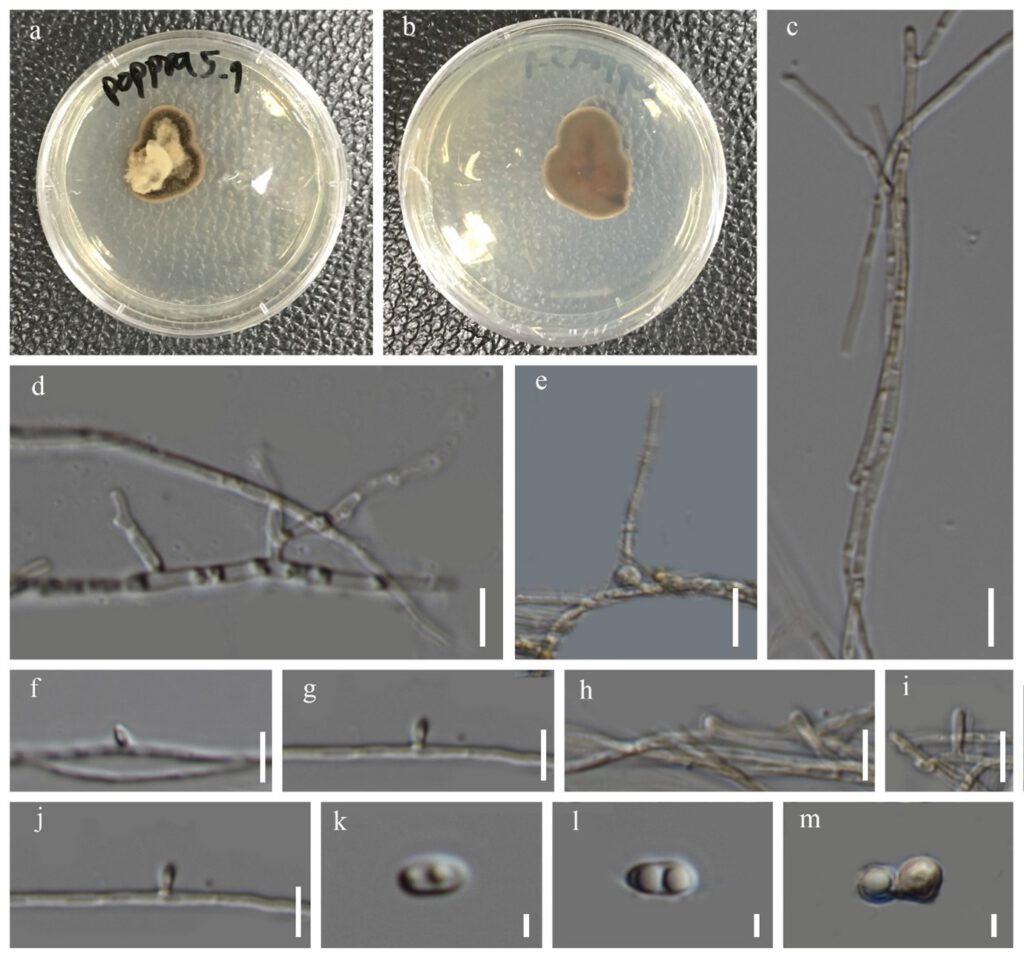Ochroconis musae (G.Y. Sun & Lu Hao) Samerp. & de Hoog, , Mycol. Progr. 14(no. 6): 8 (2015) (Dhanu)
≡ Scolecobasidium musae G.Y. Sun & Lu Hao, Mycol. Prog. 12: 492, 2013
= Ochroconis mirabilis Samerpitak & de Hoog, Fungal Divers. 65: 110, 2014.
MycoBank number: MB 808843; Index Fungorum number: IF 808843; Facesoffungi number: FoF 06957, Fig. **.
Saprobic on dead leaves of Dracaena sp. Sexual morph: Undetermined. Asexual morph: Hyphae effusae, pallide brunneae vel brunneae. Mycelium plerumque superficiale, immersum, ramosae, septatae pallide olivaceae, 1.0–1.5 μm latae. Conidiophora 0–3-septata, arising directly from aerial hyphae, straight or slightly flexuous, pale olivaceous brown, smooth, denticulate, solitary. Conidiogenous cells sympodial, denticulate, denticles thread-like, 0.5×1.0 μm, breaking between conidia and conidiogenous cells. Conidia singularia, subcylindrica, pale brown, smooth, with the distal end obtuse and proximal end slightly tapered, bearing a minute denticle, clearly 1-septate in the middle, conspicuously constricted at the septum
Culture characteristics – On PDA, colonies 25–30 mm in diameter after 2 weeks, flat, moderately expanding, smooth, dry, flat, greyish brown to dark brown, submerged colony margin, reverse as dark brown in the central portion, not producing pigmentation in agar, hyphae sub-hyaline to pale brown, smooth- and thick-walled, sporulated after 3 weeks. Conidiophores mostly arising laterally from vegetative hyphae, erect or flexuous, cylindrical with 1–2 septa, at 25 °C.
Material examined – Thailand, Tak Province, Umpang distric, on dead leaves of Dracaena sp., 23 August 2019, Napalai Chaiwan, poppra5.1 (MFLUCC****, living culture).
Host – Banana (Musa basjoo) (Samerpitak et al. 2015), Dracaena sp.—(This study).
Distribution – China (Samerpitak et al. 2015), Thailand—(Hyde et al. 2020, This study).
GenBank accession numbers – MFLU **; ITS: ***; LSU: ***
Notes – Ochroconis musae is a strain recorded from the different host of Musa basjoo (Samerpitak et al. 2015). Our strain collected from Dracaena sp. in Thailand same the result from previous report from Hyde et al. 2020. The phylogenetic analysis of our isolates from this study grouped it with Ochroconis musae species with 88% ML. Thus we identified the species as O. musae is the record from Dracaena fragrans in Thailand. In a BLASTn search of GenBank, the ITS sequence had 98.45% similarity. Thus, the new strain is introduced as a new host record from Dracaena sp. (this study).

Figure ***– Ochroconis musae (Poppra5.1 MFLU ***, living culture). a–b Culture on PDA. c–e Conidiophores f–j Conidiogenous cell. k–m Conidia. Scale bars: c–m = 10 µm.
